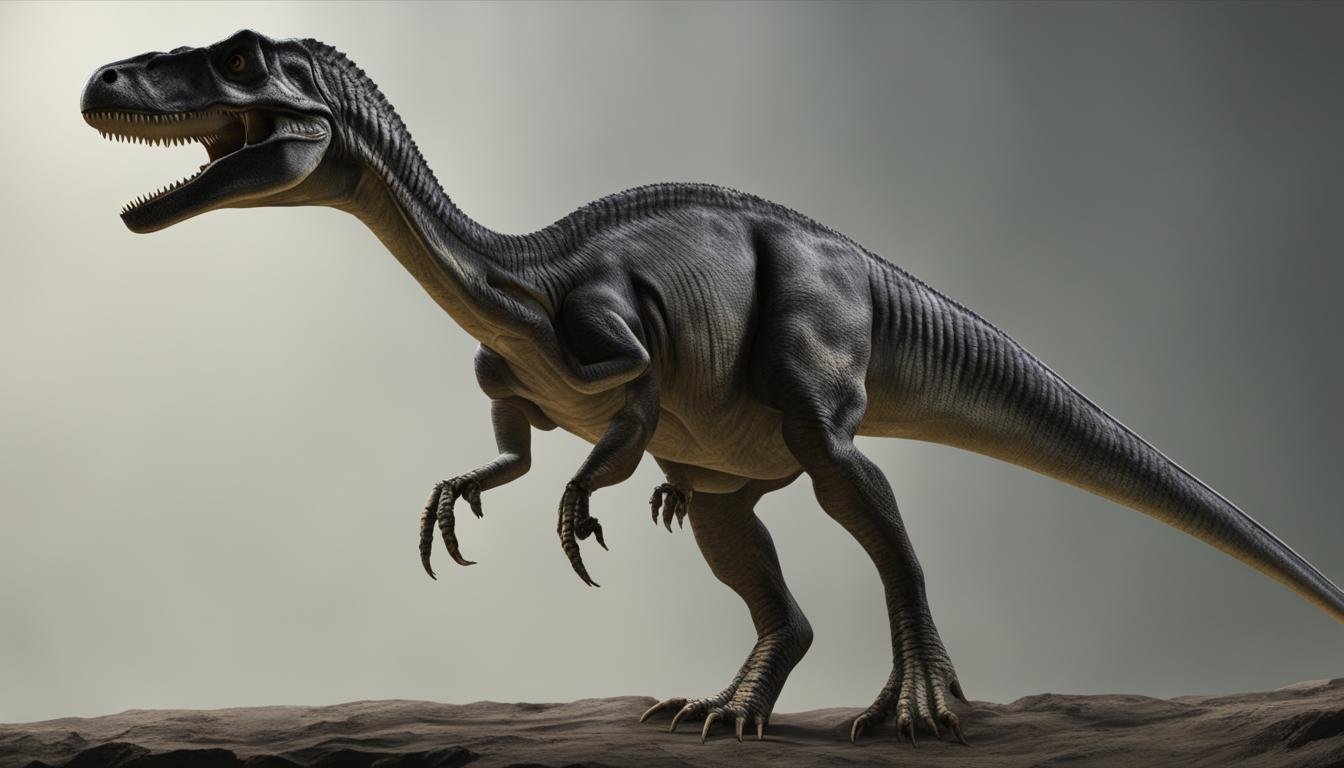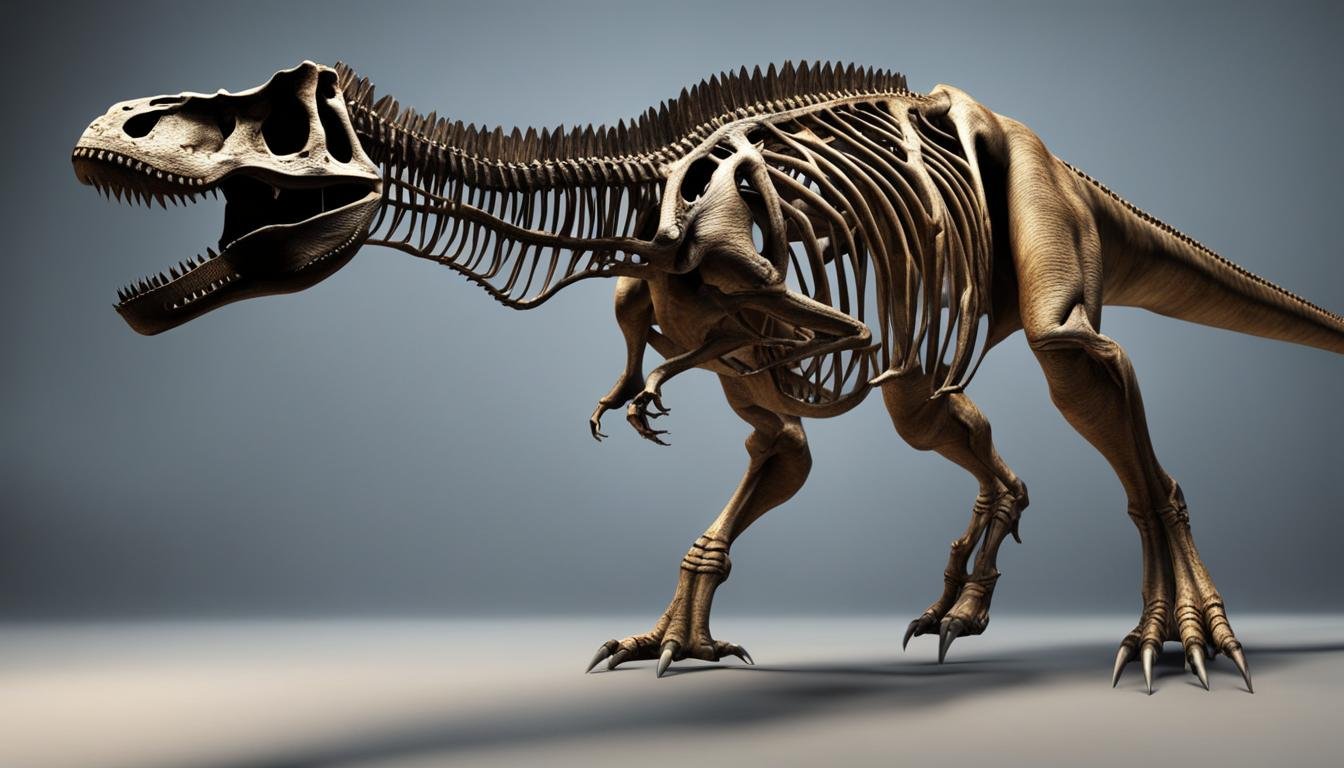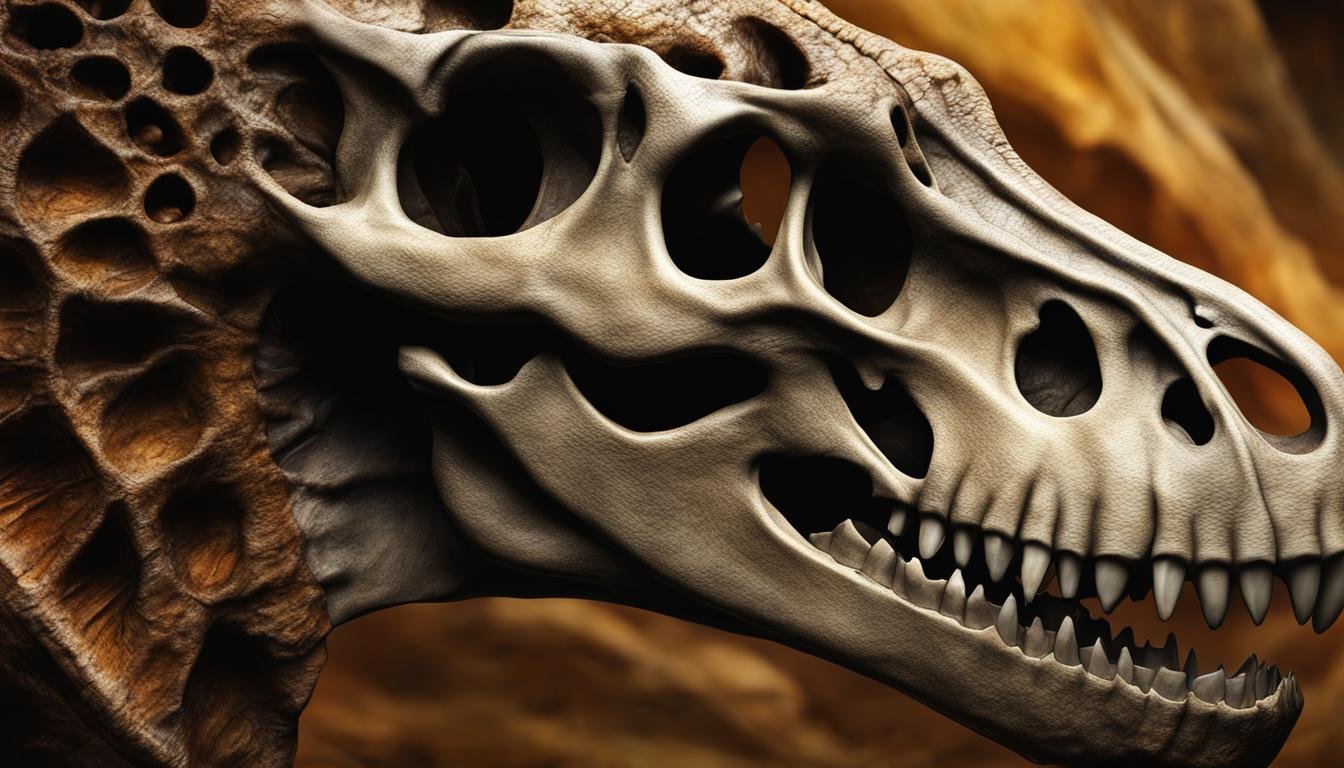Welcome to our exploration of the fascinating world of dinosaur tails. In this article, we will delve into the various functions served by these incredible appendages. From balance and defense mechanisms to communication and signaling, dinosaur tails played a crucial role in the lives of these ancient creatures. Let’s uncover the secrets of their remarkable tails and the important roles they played in the survival and behavior of dinosaurs.
The Size and Power of Dinosaur Tails
Dinosaur tails varied in size and power, playing a crucial role in their locomotion and survival. Carnivorous dinosaurs, such as the mighty T-rex, possessed large and powerful tails that aided them in hunting and capturing prey. Additionally, herbivorous dinosaurs like the Brontosaurus and Apatosaurus, both sauropods, had long tails that helped them maintain balance while walking and eating vegetation.
One remarkable example of a sauropod tail is found in the Diplodocus, which had the longest tail of any known dinosaur, measuring an astounding 46 feet in length. This immense tail provided additional balance and stability to support its massive body. The combination of size and power in these dinosaur tails enabled them to adapt to their respective environments and fulfill their various functions.
“Dinosaur tails were not only impressive in size, but they also exhibited incredible strength and flexibility.”
It is fascinating to consider the adaptations and differences in tail structure between carnivorous and herbivorous dinosaurs. While carnivorous dinosaurs utilized their tails for predatory purposes, herbivorous dinosaurs relied on them for balance and stability. This contrast highlights the diverse ways in which dinosaur tails evolved to meet the specific needs of different species.
| Dinosaur Species | Tail Size | Main Function |
|---|---|---|
| Brontosaurus | Long | Balance and stability |
| Apatosaurus | Long | Balance and stability |
| T-rex | Powerful | Hunting and prey capture |
The size and power of dinosaur tails reveal the diverse range of functions they served. From balance and stability to hunting and prey capture, these remarkable appendages played a crucial role in the survival and behavior of these ancient creatures.
The Function of Dinosaur Tails
In the world of dinosaurs, tails served a variety of functions, including balance, defense, and signaling. Let’s explore how these magnificent creatures utilized their tails to adapt and survive in their environments.
Balance and Counterbalance
For sauropods like the Brontosaurus and Apatosaurus, their long tails played a crucial role in maintaining balance as they navigated their massive bodies. These tails acted as a counterbalance, allowing these giants to keep themselves centered and stable. The T-rex, with its heavy head, relied on its tail to counterbalance and maintain stability while on the hunt. Even smaller dinosaurs like the Velociraptor utilized their tails to quickly change direction and maintain balance while running.
Defense Mechanisms
Some dinosaurs developed specialized tail structures as a means of defense. The Ankylosaurus, for example, had a spiked tail which it used to protect itself from predators. Similarly, the Stegosaurus had large tail spikes that served as a deterrent for potential attackers. These unique adaptations allowed these dinosaurs to fend off threats and increase their chances of survival.
Communication and Signaling
Dinosaur tails were also used for communication and signaling purposes. Certain tail gestures were likely used for social interactions among dinosaurs, conveying messages to other members of their species. Courtship displays may have involved intricate tail movements and postures to attract mates and establish dominance. These signaling functions of dinosaur tails played a crucial role in their interactions within their communities.
It’s fascinating to examine the diverse functions of dinosaur tails and how they contributed to the survival and behavior of these remarkable creatures. Through their tails, dinosaurs were able to maintain balance, defend themselves, and communicate with others. The study of dinosaur tails provides valuable insights into the world of these ancient beings and their adaptations for survival.

Defense Mechanisms
Some dinosaurs developed unique defense mechanisms, utilizing their tails as weapons to protect themselves from predators. Two notable examples are the Ankylosaurus and the Stegosaurus, both known for their formidable tail defenses.
The Ankylosaurus had a spiked tail, which it could wield with great force against potential attackers. The tail was covered in bony plates called osteoderms and ended in a cluster of large, sharp spikes. These spikes, combined with the brute strength of the dinosaur, made the Ankylosaurus a formidable opponent.
The Stegosaurus, on the other hand, had distinctive tail spikes. These triangular-shaped plates, called thagomizers, were lined up in pairs and could grow up to 3 feet in length. The Stegosaurus would swing its tail from side to side, using the spikes to deter predators and potential threats.
The Ankylosaurus and the Stegosaurus demonstrate the incredible adaptations of dinosaur tails for defense. These unique tail structures served as powerful weapons, ensuring the survival of these ancient creatures.
Comparison of Tail Defenses
| Dinosaur | Tail Defense |
|---|---|
| Ankylosaurus | Spiked Tail |
| Stegosaurus | Tail Spikes (thagomizers) |
The table above summarizes the defense mechanisms of the Ankylosaurus and the Stegosaurus. While both dinosaurs relied on their tails for protection, they had different types of tail defenses. The Ankylosaurus used its spiked tail, whereas the Stegosaurus had tail spikes called thagomizers. These adaptations are a testament to the diversity of tail structures among dinosaurs and their ability to adapt to their environments.
Overall, the defense mechanisms of these dinosaurs highlight the importance of the tail in their survival. By utilizing their tails as weapons, these dinosaurs were able to defend themselves and thrive in their prehistoric habitats.
Communication and Signaling
Dinosaur tails played a crucial role in communication and signaling among these ancient creatures. Through tail gestures and movements, dinosaurs were able to convey messages and interact with members of their own species. These signals were essential for various social interactions, including courtship displays and establishing dominance within a group.
One theory suggests that certain tail postures and movements were used during courtship displays to attract mates. By showcasing their tail in a specific way, dinosaurs could communicate their readiness to mate and display their fitness as potential partners. Additionally, tail gestures may have played a role in territorial disputes and communication within social hierarchies.
Social interaction among dinosaurs may have also involved using tail gestures as a means of communication. By using their tails, dinosaurs could convey aggression, submission, or other important messages to their counterparts. Tail signals would have allowed these creatures to navigate complex social dynamics and maintain order within their communities.
“Through tail gestures and movements, dinosaurs were able to convey messages and interact with members of their own species.”
Furthermore, the size and morphology of a dinosaur’s tail may have influenced its signaling abilities. Species with longer, more flexible tails may have had a broader range of movements and gestures at their disposal, allowing for more nuanced communication. On the other hand, species with shorter tails may have relied on other forms of communication, such as vocalizations or body postures.
| Dinosaur Species | Tail Gestures |
|---|---|
| Velociraptor | – Rapid side-to-side tail movements during group coordination – Tail held high as a sign of dominance |
| Tyrannosaurus rex | – Aggressive tail swings when defending territory – Tail flicks as a warning signal to potential threats |
| Triceratops | – Slow, deliberate tail movements as a display of calm and confidence – Tail held low when submitting to a more dominant individual |
Understanding the communication and signaling functions of dinosaur tails provides valuable insights into the social lives and behaviors of these remarkable animals. By analyzing fossils, studying their anatomy, and observing modern-day behavior in related species, researchers continue to unlock the secrets of dinosaur communication and unravel the complex interactions that took place millions of years ago.
Tail Anatomy and Muscle Structure
The anatomy and muscle structure of dinosaur tails played a crucial role in their function and overall locomotion. The tails of dinosaurs were composed of several vertebrae, connected by muscles and tendons, allowing for flexibility and movement. The tail muscles provided propulsion and acted as a steering mechanism, enabling dinosaurs to navigate their environments with agility.
The tail anatomy varied among different dinosaur species, reflecting their unique adaptations and behaviors. For example, some dinosaurs had tails that were long and powerful, while others had tails with specialized structures like spikes or clubs. These variations in tail anatomy influenced how dinosaurs used their tails for different purposes, such as balance, defense, and communication.
“The anatomy of dinosaur tails allowed for a wide range of movements and functions. The combination of muscle strength and flexibility enabled dinosaurs to engage in various activities, from hunting to courtship displays.”
Tail Flexibility
The flexibility of dinosaur tails was essential for their survival and success in various environments. The ability to flex and move the tail allowed dinosaurs to make quick changes in direction while running or maneuvering through dense vegetation. This flexibility also played a role in maintaining balance and stability, especially for larger dinosaurs with heavy bodies.
The tail flexibility varied among different dinosaur species, depending on their specific adaptations and behaviors. Some dinosaurs had more rigid tails, suitable for delivering powerful strikes or defense mechanisms, while others had highly flexible tails, enabling them to navigate complex terrains and environments.
Overall, the tail anatomy and muscle structure of dinosaurs provided them with a versatile tool for movement, balance, and interaction with their surroundings. The diverse functions and adaptations of dinosaur tails highlight their importance in understanding the behavior and evolution of these fascinating creatures.
| Function | Tail Anatomy | Muscle Structure |
|---|---|---|
| Balance | Varying lengths and shapes | Muscles for weight distribution and stability |
| Defense | Spikes, clubs, or bony structures | Powerful muscles for striking or deterrence |
| Propulsion | Flexible vertebral column | Muscles for tail movement and steering |
| Steering Mechanism | Mobile joints between vertebrae | Muscles for precise control and direction changes |
| Tail Flexibility | Varying degrees of flexibility | Adapted muscles for agile movements |
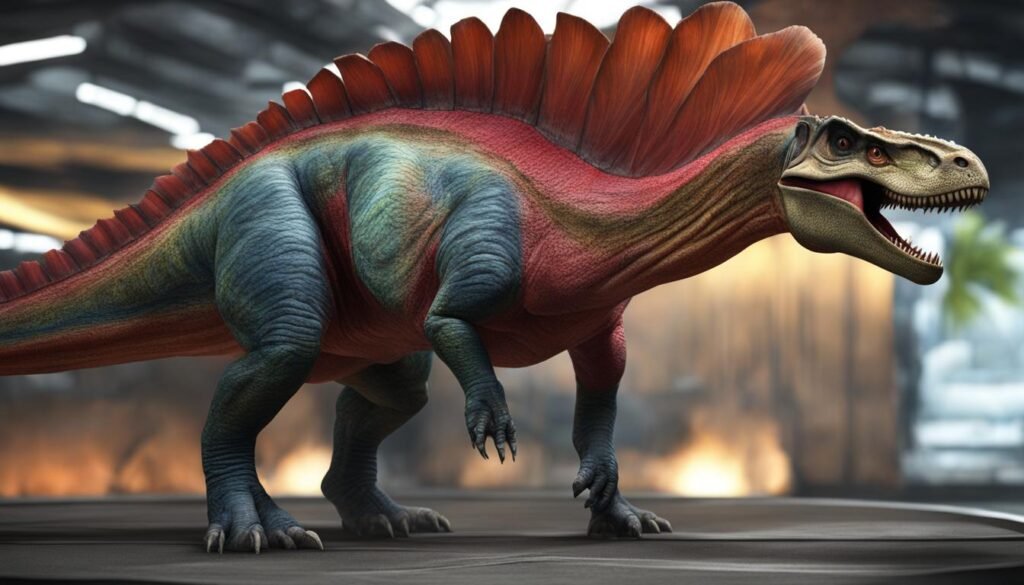
Tail as a Defensive Weapon
Some dinosaurs possessed specialized tail structures that served as defensive weapons, allowing them to protect themselves from predators. Two notable examples of dinosaurs with defensive tail adaptations are the Ankylosaurus and the Stegosaurus.
The Ankylosaurus had a bony tail club, which it could swing at predators with great force. This tail club was made up of several fused vertebrae and was covered in a thick layer of bone, making it a formidable weapon for self-defense.
The Stegosaurus, on the other hand, had large, sharp tail spikes known as “thagomizers.” These spikes protruded from the end of its tail and acted as a deterrent to potential threats.
These defensive adaptations highlight the importance of the tail in the survival and defense of dinosaurs. By utilizing their tails as weapons, these dinosaurs were able to fend off predators and increase their chances of survival in their respective environments.
| Dinosaur | Defensive Tail Adaptation |
|---|---|
| Ankylosaurus | Bony tail club |
| Stegosaurus | Large, sharp tail spikes |
Aquatic Adaptation of Dinosaur Tails
Some dinosaurs had the remarkable ability to adapt to aquatic environments, and their tails played a crucial role in their swimming and propulsion. These dinosaurs, known as aquatic dinosaurs, developed unique tail morphologies and structures that enabled them to navigate their aquatic habitats with efficiency and effectiveness.
The most notable adaptation for swimming among aquatic dinosaurs was the presence of a specialized tail fin. This tail fin, similar to those found in modern-day fish and marine mammals, provided the necessary surface area to generate propulsion and control movement in the water. The tail fin allowed aquatic dinosaurs to swim gracefully and with precision, making them well-adapted to their aquatic lifestyles.
Throughout the course of evolution, aquatic dinosaurs exhibited a wide range of tail morphologies suited to their specific needs. Some had long and slender tails, resembling those of modern-day crocodiles, which allowed for agile swimming and maneuverability. Others had fluke-like tails, similar to those found in whales, which provided powerful thrust and stability in the water. The diversity in tail morphology among aquatic dinosaurs showcases the remarkable adaptability of these prehistoric creatures.
| Dinosaur Species | Tail Morphology |
|---|---|
| Spinosaurus | Long, slender tail |
| Plesiosaurus | Fluke-like tail |
| Mosasaurus | Powerful, muscular tail |
“The aquatic adaptation of dinosaur tails highlights the incredible diversity and versatility of these ancient creatures. Their ability to thrive in aquatic environments further demonstrates the evolutionary ingenuity of dinosaurs.”
Understanding the aquatic adaptation of dinosaur tails provides valuable insights into how these prehistoric creatures navigated and survived in different environments. The presence of a specialized tail fin, combined with varying tail morphologies, allowed them to swim with ease and efficiency. The study of aquatic dinosaurs and their tails continues to reveal fascinating discoveries about the incredible world of dinosaurs.
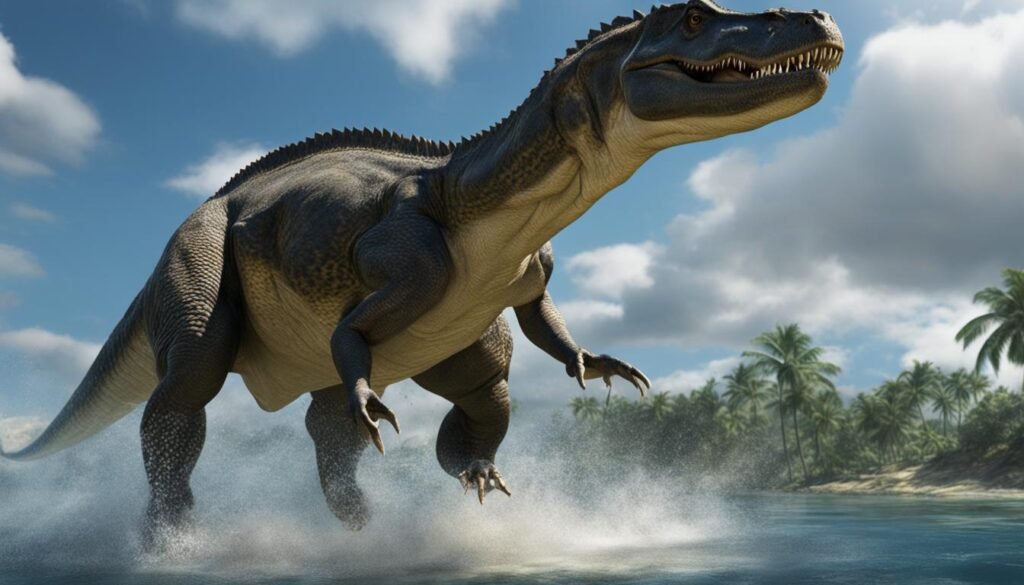
The Adaptation of Spinosaurus
Spinosaurus, one of the most famous aquatic dinosaurs, had a unique tail adaptation that enabled it to excel in water. Its long, slender tail enhanced stability and control while swimming. The tail acted as a rudder, allowing Spinosaurus to change direction swiftly and navigate its underwater habitat with precision. The aquatic adaptation of Spinosaurus’ tail showcases the remarkable capabilities of dinosaur tails in adapting to different environments.
Tail in Speed Regulation
One of the important functions of dinosaur tails was speed regulation. The tail movement played a crucial role in sprinting, turning, and maintaining stability during locomotion. By controlling their tails, dinosaurs were able to achieve remarkable agility and adaptability in their movements.
When it comes to sprinting, the tail served as a counterbalance to the dinosaur’s body, allowing for efficient acceleration and increased speed. By rapidly swaying their tails from side to side, the dinosaurs could generate additional momentum, propelling themselves forward with greater force. This tail movement enabled them to outrun their prey or escape from predators.
Moreover, the tail provided stability during high-speed pursuits or sudden changes in direction. By using their tails as a rudder, dinosaurs could maintain balance and control while making sharp turns. The ability to maneuver swiftly and maintain stability gave them a competitive advantage in their environment.
“The tail was crucial for speed regulation in dinosaurs. Its movement allowed for quick sprints and facilitated turning during pursuit or escape. By controlling their tails, dinosaurs could maintain stability while running, making them agile and effective predators or prey.”
The relationship between speed regulation and tail movement can be observed in various dinosaur species. For example, the agility and speed of the Velociraptor were enhanced by its long, flexible tail. The tail acted as a rudder, enabling the Velociraptor to change direction rapidly while maintaining stability.
| Dinosaur Species | Speed (mph) |
|---|---|
| Tyrannosaurus Rex | 20 – 25 |
| Velociraptor | 40 – 45 |
| Stegosaurus | 5 – 7 |
“The tail played a vital role in speed regulation and stability. By utilizing their tails, dinosaurs achieved remarkable agility and adaptability in their movements.”
In conclusion, the tail functioned as a crucial component in the speed regulation of dinosaurs. Through tail movement, dinosaurs could sprint, turn, and maintain stability, allowing them to be agile and effective predators or prey. The ability to control their tails provided them with a competitive advantage in their environment, enabling them to navigate various terrains and swiftly pursue or evade targets.
Tail as a Means of Proprioception
The function of dinosaur tails extended beyond balance and defense mechanisms. The tail played a crucial role in proprioception, which refers to the awareness of body position and movement. Through sensory feedback, dinosaurs were able to maintain balance and coordination, allowing them to navigate their environment with precision. The variation in tail length and morphology among different dinosaur species influenced their proprioceptive abilities and overall biomechanics.
Proprioception was essential for dinosaurs to effectively control their movements and respond to stimuli in their surroundings. The tail provided valuable information about the position and movement of their bodies, allowing them to make quick adjustments and maintain stability. This enabled dinosaurs to move efficiently and adapt to various terrains, enhancing their survival and hunting capabilities.
The tail provided valuable information about the position and movement of dinosaurs’ bodies, allowing them to make quick adjustments and maintain stability.
In addition to proprioception, the tail also played a role in the generation and control of kinetic energy. As dinosaurs moved, their tails contributed to the transfer of energy from the ground to their bodies, enabling powerful strides and agile movements. The length and morphology of the tail influenced the efficiency of energy transfer, thereby impacting the overall locomotion and speed of dinosaurs.
Understanding the significance of proprioception and the role of the tail in kinetic energy provides valuable insights into the biomechanics and movement capabilities of dinosaurs. By analyzing the tail length variation and tail morphology across different species, scientists can gain a deeper understanding of how dinosaurs evolved and adapted to their environments. The study of proprioception in dinosaur tails expands our knowledge of these prehistoric creatures and sheds light on their remarkable physical abilities.
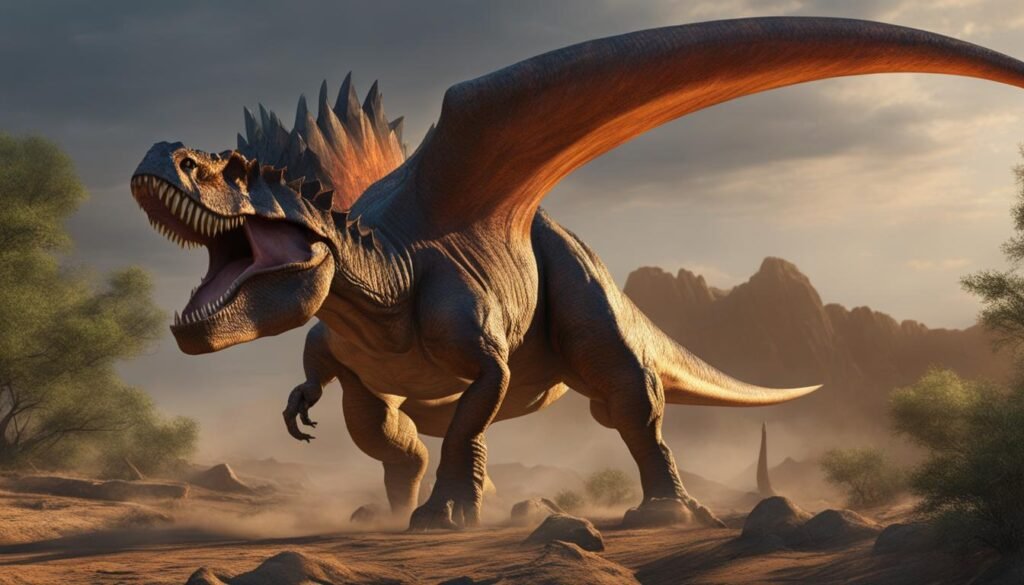
| Dinosaur Species | Tail Length | Tail Morphology |
|---|---|---|
| Tyrannosaurus Rex | Approximately 4 meters | Long and robust tail for balance and stability |
| Stegosaurus | Approximately 2.75 meters | Short tail with large spikes for defense |
| Diplodocus | Approximately 14 meters | Extremely long tail for balance and communication |
| Velociraptor | Approximately 1 meter | Flexible tail for quick changes in direction |
Conclusion
In conclusion, dinosaur tails played a vital role in their survival and adaptation. These remarkable appendages served various functions, including balance, defense, communication, and signaling.
The size, shape, and structure of dinosaur tails were specifically adapted to meet the unique needs of each species. Some dinosaurs, such as the sauropods, relied on their long tails to maintain balance and counterbalance their massive bodies. Others, like the Ankylosaurus and Stegosaurus, used their tails as defensive weapons with spiked clubs and sharp spikes.
Furthermore, dinosaur tails were used for communication and signaling among individuals. Tail gestures and postures were likely employed for social interaction, courtship, and establishing dominance within their species.
The study of dinosaur tails provides valuable insights into the behavior, adaptations, and biomechanics of these incredible creatures. By understanding the function and significance of dinosaur tails, we gain a deeper appreciation for the complexity and diversity of the prehistoric world.






